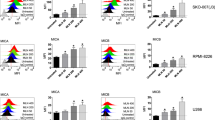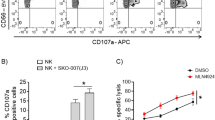Abstract
Natural killer (NK) cells target and kill tumor cells by direct anti-tumor cytotoxicity. NK lytic-associated molecule (NKLAM) is a protein involved in this cytolytic function. Acting as an E3 ubiquitin ligase, NKLAM binds to and ubiquitinates a novel protein, uridine-cytidine kinase like-1 (UCKL-1), targeting it for degradation. However, UCKL-1’s function in tumor cell survival and NK cell cytotoxicity is unknown. UCKL-1’s homology to uridine kinases and over expression in tumor cells suggests a role for UCKL-1 in tumor growth and/or survival. We propose that NKLAM and UCKL-1 interact in the tumor cell, where degradation of UCKL-1 leads to increased tumor cell apoptosis. Here we use RNA interference to downregulate UCKL-1 expression in K562 erythroleukemia cells. It was seen that downregulation of UCKL-1 initiated apoptosis and slowed the cell cycle, resulting in lower growth in the small interfering UCKL-1 RNA treated K562 cell culture. In addition, the chemotherapeutic agent staurosporine was seen to be more effective in inducing cell death by apoptosis in UCKL-1 depleted K562 cells compared with controls. We also found that UCKL-1 depleted K562 cells were more susceptible to NK mediated cytolysis than controls. These results indicate a role for UCKL-1 in tumor cell survival and suggest possible therapeutic potential of UCKL-1 inhibitors in cancer treatment.






Similar content being viewed by others
References
Ljunggren HG, Malmberg KJ (2007) Prospects for the use of NK cells in immunotherapy of human cancer. Nat Rev Immunol 7:329–338. doi:10.1038/nri2073
Hallet WHD, Murphy WJ (2004) Natural killer cells: Biology and clinical use in cancer therapy. Cell Mol Immunol 1:12–21
Guerra N, Tan YX, Joncker NT, Choy A, Gallardo F, Xiong N, Knoblaugh S, Cado D, Greenberg NM, Raulet DH (2008) NKG2D-deficient mice are defective in tumor surveillance in models of spontaneous malignancy. Immunity 28:571–580. doi:10.1016/j.immuni.2008.02.016
Ljunggren HG (2008) Cancer immunosurveillance: NKG2D breaks cover. Immunity 28:492–494. doi:10.1016/j.immuni.2008.03.007
Groh V, Rhinehart R, Secrist H, Bauer S, Grabstein KH, Spies T (1999) Broad tumor-associated expression and recognition by tumor-derived gamma delta T cells of MICA and MICB. Proc Natl Acad Sci 96:6879–6884
Cerwenka A, Bakker ABH, McClanahan T, Wagner J, Wu J, Phillips JH, Lanier LL (2000) Retinoic acid early inducible genes define a ligand family for the activating NKG2D receptor in mice. Immunity 12:721–727. doi:10.1016/S1074-7613(00)80222-8
Diefenbach A, Jamieson AM, Liu SD, Shastri N, Raulet DH (2000) Ligands for the murine NKG2D receptor: expression by tumor cells and activation of NK cells and macrophages. Nat Immunol 1:119–126. doi:10.1038/77793
Pende D, Cantoni C, Rivera P, Vitale M, Castriconi R, Marcenaro S, Nanni M, Biassoni R, Bottino C, Moretta A, Moretta L (2001) Role of NKG2D in tumor cell lysis mediated by human NK cells: cooperation with natural cytotoxicity receptors and capability of recognizing tumors of nonepithelial origin. Eur J Immunol 31:1076–1086. doi:10.1002/1521-4141(200104)31:4<1076::AID-IMMU1076>3.0.CO;2-Y
Pende D, Rivera P, Marcenaro S, Chang CC, Biassoni R, Conte R, Kubin M, Cosman D, Ferrone S, Moretta L, Moretta A (2002) Major histocompatibility complex class 1-related chain A and UL-16 binding protein expression on tumor cell lines of different histotypes: analysis of tumor susceptibility to NKG2D-dependent natural killer cell cytotoxicity. Cancer Res 62:6178–6186
Vivier E, Nunes JA, Vely F (2004) Natural killer cell signaling pathways. Science 306:1517–1519. doi:10.1126/science.1103478
Lieberman J (2003) The ABCs of granule-mediated cytotoxicity: new weapons in the arsenal. Nat Rev Immunol 3:361–370. doi:10.1038/nri1083
Kozlowski M, Schorey J, Portis T, Grigoriev V, Kornbluth J (1999) NK lytic associated molecule: a novel gene selectively expressed in cells with cytolytic function. J Immunol 163:1775–1785
Fortier JM, Kornbluth J (2006) NK lytic-associated molecule, involved in NK cytotoxic function, is an E3 ligase. J Immunol 176:6463–6465
Ardley HC, Robinson PA (2005) E3 ubiquitin ligases. Essays Biochem 41:15–30
Capili AD, Edghill EL, Wu K, Borden KLB (2004) Structure of the C-terminal RING finger from a RING IBR-RING/TRIAD motif reveals a novel zinc binding domain distinct from a RING. J Mol Biol 340:1117–1129. doi:10.1016/j.jmb.2004.05.035
Cheng N, Payne RC, Traut TW (1986) Regulation of uridine kinase: evidence for a regulatory site. J Biol Chem 261:13006–13012
Greengard O, Head JF, Goldberg SL (1980) Uridine kinase, adenylate kinase, and guanase in human lung tumors. Cancer Res 40:2295–2299
Kasuba E, Kashuba V, Sandalova T, Klein G, Szekely L (2002) Epstein-Barr virus encoded nuclear protein EBNA-3 binds a novel human uridine kinase/uracil phosphoribosyltransferase. BMC Cell Biol 3:23–35. doi:10.1186/1471-2121-3-23
Kim SH, Hwang CI, Juhnn YS, Lee JH, Park WY, Song YS (2007) GADD153 mediates celecoxib-induced apoptosis in cervical cancer cells. Carcinogenesis 28:223–231. doi:10.1093/carcin/bgl227
Hasinoff BB, Abram ME, Barnabe N, Khelifa T, Allan WP, Yalowich JC (2001) The catalytic DNA topoisomerase II inhibitor dexrazoxane (ICRF-187) induces differentiation and apoptosis in human leukemia K562 Cells. Mol Pharmacol 59:453–461
Tolomeo M, Grimaudo S, Di Cristina A, Pipitone RM, Dusonchet L, Meli M, Crosta L, Gebbia N, Invidiata FP, Titone L, Simoni D (2008) Galangin increases the cytotoxic activity of imatinib mesylate in imatinib-sensitive and imatinib resistant Bcr-Abl expressing leukemia cells. Cancer Lett 265:289–297. doi:10.1016/j.canlet.2008.02.025
Tepper AD, de Vries E, van Blitterswijk J, Borst K (1999) Ordering of ceramide formation, caspase activation, and mitochondrial changes during CD95- and DNA damage–induced apoptosis. J Clin Invest 103:971–978. doi:10.1172/JCI5457
Jacquel A, Herrant M, Legros L, Belhacene N, Luciano F, Pages G, Hofman P, Auberger P (2003) Imatinib induces mitochondria-dependent apoptosis of the Bcr-Abl-positive K562 cell line and its differentiation toward the erythroid lineage. FASEB J 17:2160–2162. doi:10.1096/fj.03-0322fje
Martins LM, Mesner PW, Kottke TJ, Basi GS, Sinha S, Tung JS, Svingen PA, Madden BJ, Takahashi A, McCormick DJ, Earnshaw WC, Kaufmann SH (1997) Comparison of caspase activation and subcellular localization in HL-60 and K562 cells undergoing etoposide-induced apoptosis. Blood 90:4283–4296
Horton PA, Longley RE, McConnell OJ, Ballas LM (1994) Staurosporine aglycone (K562-c) and arcyriaflavin A from the marine ascidian, Eudistoma sp. Experientia 50:843–845
Zhang L, Higuchi M, Totpal K, Chaturvedi MM, Aggarwal BB (1994) Staurosporine induces the cell surface expression of both forms of human tumor necrosis factor receptors on myeloid and epithelial cells and modulates ligand-induced cellular response. J Biol Chem 269:10270–10279
Yen A, Varvayanis S, Platko JD (1993) 12-o-tetradecanoylphorbol-13-acetate and staurosporine induce increased retinoblastoma tumor supressor gene expression with megakaryocytic differentiation of leukemic cells. Cancer Res 53:3085–3091
Kornbluth J, Flomenberg N, Dupont B (1982) Cell surface phenotype of a cloned line of human natural killer cells. J Immunol 129:2831–2837
Darzynkiewicz Z, Juan G, Darzynkiewicz Z (1997) DNA content measurement for DNA ploidy and cell cycle analysis. In: Robinson JP, Darzynkiewicz Z, Dean PN et al (eds) Current protocols in cytometry. Wiley, New York, pp 7.5.1–7.5.24
Roden MM, Lee KH, Panellia MC, Marincola FM (1999) A novel cytolysis assay using fluorescent labeling and quantitative fluorescent scanning technology. J Immunol Methods 24:29–41
Cullen B (2006) Enhancing and confirming the specificity of RNAi experiments. Nature Methods 3:677–681
Lock RB, Thompson BS, Sullivan DM, Stribinskiene L (1997) Potentiation of etoposide-induced apoptosis by staurosporine in human tumor cells is associated with events downstream of DNA-protein complex formation. Cancer Chemother Pharmacol 39:399–409
Acknowledgments
This material is based on work supported by a merit review grant from the Department of Veterans Affairs, Veterans Health Administration, Office of Research and Development, and Biomedical Laboratory Research and Development.
Conflict of interest statement
The authors declare that they have no conflict of interest.
Author information
Authors and Affiliations
Corresponding author
Rights and permissions
About this article
Cite this article
Ambrose, E.C., Kornbluth, J. Downregulation of uridine-cytidine kinase like-1 decreases proliferation and enhances tumor susceptibility to lysis by apoptotic agents and natural killer cells. Apoptosis 14, 1227–1236 (2009). https://doi.org/10.1007/s10495-009-0385-z
Published:
Issue Date:
DOI: https://doi.org/10.1007/s10495-009-0385-z




